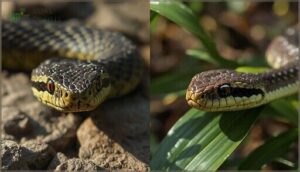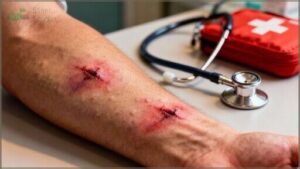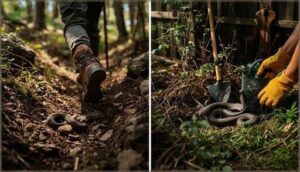This site is supported by our readers. We may earn a commission, at no cost to you, if you purchase through links.
A snake’s fangs puncture skin faster than you can blink—literally. The strike covers half the snake’s body length in under a second, delivering venom through a structure that works like a precision hypodermic needle. But the physical bite is just the beginning.
Up to 67% of venomous snake bite survivors develop PTSD symptoms, and the medical complications can range from tissue death to kidney failure. You need accurate information about snake bites—how they happen, what venom does to your body, how to recognize the warning signs, and what actions can save your life.
Whether you’re hiking backcountry trails, working outdoors, or simply want to protect your family, understanding snake bite mechanics, symptoms, and prevention strategies gives you the knowledge to stay safe and respond effectively when seconds count.
Table Of Contents
- Key Takeaways
- What Happens When a Snake Bites?
- Venomous Vs. Non-Venomous Snake Bites
- Types of Snake Venom and Their Effects
- Recognizing Snake Bite Symptoms
- First Aid and Emergency Response Steps
- Medical Treatment and Recovery
- Preventing Snake Bites Outdoors and at Home
- Snake Bite Facts, Statistics, and Real Videos
- Frequently Asked Questions (FAQs)
- What are some of the most dangerous venomous snakes globally?
- How long can a snake go without eating?
- Why do snakes flick their tongues?
- How do snakes hear and smell?
- Why do snakes shed their skin?
- What should you do if you see a snake?
- Can all snakes climb trees or swim?
- How do you handle a snake safely?
- When are snakes most active during the year?
- Are there non-lethal snakebite effects long-term?
- Conclusion
Key Takeaways
- Snake strikes happen in under a second with fangs that work like hypodermic needles, but the real danger isn’t just physical—up to 67% of venomous bite survivors develop PTSD, depression, or anxiety that reshapes their lives long after the wound heals.
- Venom types determine what happens to your body: cytotoxins destroy tissue at the bite site, neurotoxins paralyze your breathing muscles, and hemotoxins wreck your blood’s ability to clot—knowing the difference helps you recognize when you need antivenom immediately.
- Protective clothing like heavy denim or snake boots reduces venom delivery by 60-66% and turns about a third of strikes into dry bites, making layered barriers one of your most practical defenses in high-risk terrain.
- The first minutes after a bite matter most—keep the limb still and below heart level, call emergency services immediately, and avoid common mistakes like applying ice, cutting the wound, or using tourniquets that actually worsen tissue damage.
What Happens When a Snake Bites?
A snake bite isn’t just a simple puncture wound—it’s a complex event that triggers both physical and psychological responses in your body. Understanding what actually happens during and after a bite can help you respond effectively in an emergency.
Let’s break down the mechanics of snake bites, their immediate physical effects, and the often-overlooked emotional aftermath.
How Snakes Bite and Why
Snakes strike with stunning speed—some vipers complete the motion in 20–60 milliseconds, faster than you can blink. Their bite mechanics blend evolutionary precision with survival instinct:
- Strike mechanics involve rapid head acceleration over half the snake’s body length
- Fang structure acts like a hypodermic needle, channeling venom instantly
- Bite speed exceeds 2 meters per second in controlled conditions
- Snake agility allows mid-strike adjustments to improve placement
Snakes bite to capture prey or defend themselves when threatened. Understanding the snake bite mechanics is essential for developing effective treatments.
Physical Effects of Snake Bites
The moment venom enters your body, a cascade of physical damage begins. Tissue damage manifests as severe pain and swelling within 30 to 60 minutes, often spreading across an entire limb. Systemic reactions trigger bleeding disorders and cardiovascular collapse. Neurotoxin effects cause muscle paralysis, potentially leading to respiratory failure.
Some survivors face chronic disabilities—muscle wasting, reduced joint motion, even amputations—that persist for years after the initial bite. The long-term effects of snake envenoming can lead to chronic kidney issues that require ongoing medical attention.
Emotional Impact of Snake Bites
Beyond the physical wounds, your mind carries its own scars. Research shows up to 67% of venomous snake bite survivors develop PTSD symptoms—intrusive memories, nightmares, and persistent fear that reshape daily life. Depression affects 25% to 54% of victims, while anxiety disorders compound the trauma.
Beyond physical injuries, up to 67% of snake bite survivors develop PTSD, depression, and anxiety that reshape their lives
These mental health challenges demand attention alongside emergency treatment and first aid, yet psychological recovery remains vastly under-researched compared to physical healing.
Venomous Vs. Non-Venomous Snake Bites
Not all snake bites carry the same level of danger. The difference between venomous and non-venomous bites isn’t always obvious in the moment, but understanding what sets them apart can shape how you respond.
Let’s break down the key differences, how to spot venomous species, and why even non-venomous bites deserve your attention.
Key Differences in Bite Effects
When a venomous snake strikes, the type of venom and the severity of the bite determine the subsequent effects. Venomous snakes inject toxins that can cause systemic reactions, such as neurotoxins paralyzing muscles, hemotoxins disrupting blood clotting, and cytotoxins destroying tissue. In contrast, non-venomous bites result in puncture wounds and localized pain without progressive swelling or internal damage. Understanding these distinctions is crucial for effective wound management, emergency response, and first aid.
| Feature | Venomous Bites | Non-Venomous Bites |
|---|---|---|
| Local Effects | Progressive swelling, blistering, necrosis over days | Puncture wounds, minor bleeding, limited swelling |
| Systemic Symptoms | Paralysis, bleeding disorders, organ failure possible | Rare; mainly anxiety and infection risk |
| Progression | Symptoms evolve hours to days; can worsen without antivenom | Peak symptoms within hours, then gradual improvement |
| Treatment Needs | Antivenom, intensive monitoring, transfusions may be required | Wound cleaning, infection prevention, supportive care |
| Mortality Risk | Tens of thousands of deaths globally each year | Rarely fatal; complications uncommon |
Identifying Venomous Snake Species
Learning to tell the difference between harmless and dangerous snakes can protect you in the field. In North America, most venomous snake species share key traits: triangular heads, vertical pupils, and heat-sensing pits between eye and nostril. Rattlesnakes add a distinctive rattle. Coral snakes break the mold with round pupils and red-yellow-black rings where red touches yellow.
| Trait | Venomous (Pit Vipers) | Non-Venomous (Most) |
|---|---|---|
| Head Shape | Broad, triangular | Narrow, rounded |
| Pupils | Vertical, elliptical | Round |
| Heat Pits | Present between eye and nostril | Absent |
| Scales | Keeled, rough texture | Smooth |
| Subcaudal Scales | Single row | Double row |
Bite patterns and snake behavior also offer clues. Venomous snakes often strike and retreat, leaving fang punctures. Non-venomous species may bite repeatedly, producing rows of small teeth marks. Context matters—rattlesnakes favor rocky slopes and forest edges, while coral snakes hide in sandy soils. Relying on one feature alone is risky; combine head shape, pupils, pits, and habitat for accurate venomous snake identification.
Non-Venomous Bites and Their Risks
Harmless snakes still carry infection risks—bacterial flora in their mouths can contaminate puncture wounds, though studies show only 0.4% of non-envenomated patients develop serious infections. You’ll usually see local damage like small teeth marks and minor swelling. Allergic reactions remain possible even without venom, ranging from mild hives to anaphylaxis. Proper wound care prevents most complications.
| Risk Category | Non-Venomous Snake Bites |
|---|---|
| Infection Rate | ~0.4% require antibiotics |
| Local Damage | Punctures, mild swelling |
| Allergic Reactions | Rare but possible |
| Tissue Necrosis | Extremely rare |
| Typical Outcome | Full recovery with basic care |
Types of Snake Venom and Their Effects
Not all snake venom works the same way. Some venoms destroy tissue, others shut down your nervous system, and a few turn your blood into a chemical battlefield.
Let’s break down the three main types and what they actually do to your body.
Cytotoxins, Neurotoxins, and Hemotoxins
You’ll encounter three main weapons in snake venom composition: cytotoxins that destroy your cells and tissue, neurotoxins that paralyze your muscles and breathing, and hemotoxins that wreck your blood’s ability to clot.
These toxic effects from venomous snakes aren’t random—toxin classification reveals that cobras pack heavy cytotoxins while vipers load up on hemotoxins, shaping envenoming mechanisms differently depending on what bites you.
How Venom Affects The Human Body
Snake venom toxicity doesn’t just hurt—it launches a systemic assault on your body’s most critical functions. When venomous snakes inject their payload, you’re facing cellular destruction, neurological damage, and potential organ failure all at once.
Here’s what happens inside you:
- Blood chaos: Hemotoxins trigger coagulopathy in over 90% of viper bite cases, causing uncontrolled bleeding
- Breathing shutdown: Neurotoxins paralyze respiratory muscles, forcing 62.5% of patients onto ventilators
- Kidney collapse: Toxinology shows 19% need dialysis from venom-induced acute kidney injury
Your immune response fights back, but antivenom remains your best defense against these snake bite symptoms.
Videos: Venom Action Under The Microscope
You can actually watch venom destroy human cells in real-time through microscopic imaging. Recent venom microscopy reveals how snake venom triggers cell shrinkage and membrane rupture within 24–48 hours, showing exactly why venomous snakes cause such devastating tissue damage at bite sites.
| Venom Type | Microscopic Effects |
|---|---|
| Viperid venoms | Cell rounding, detachment, membrane disruption |
| Elapid venoms | Distinct shrinkage patterns, surface area loss |
| Cobra toxins | Neuromuscular junction blockade, receptor binding |
Toxinology videos now demonstrate hemotoxic venom clotting blood samples instantly, while cell damage studies track how cytotoxins and metalloproteinases destroy keratinocytes. These microscopic effects directly explain snake bite symptoms—from local necrosis to systemic organ failure. Venom research using fluorescent staining highlights why antivenom must work fast.
Recognizing Snake Bite Symptoms
Knowing what to look for after a snake bite can save your life. Symptoms vary depending on whether the snake injected venom and what kind of toxins are involved.
Here’s how to recognize the warning signs your body sends when it’s been bitten.
Local and Systemic Symptoms
When venom enters your body, you’ll notice changes both at the bite site and throughout your system. Local symptoms like severe pain, swelling, and bruising usually appear within 30–60 minutes—sometimes massive swelling develops over two to three days.
Systemic reactions include weakness, nausea, dizziness, and rapid heart rate. These signs indicate venom spreading beyond the wound, requiring immediate medical attention for proper wound care and pain management.
Signs of Severe Envenoming
When symptoms escalate beyond the initial pain and swelling, you’re facing severe envenoming—a medical emergency demanding immediate treatment. Watch for these danger signs:
- Breathing difficulties or muscle paralysis from neurotoxic venom effects
- Uncontrolled bleeding from gums, nose, or bite site indicating coagulopathy
- Shock symptoms—rapid pulse, cold skin, confusion, or collapsing blood pressure
- Dark urine or no urination signaling potential kidney failure
These toxicology red flags require emergency response and antivenom without delay.
Bite Site Characteristics
Looking at the wound itself tells you a lot. Venomous snakes usually leave one or two deep fang marks, while nonvenomous bites show multiple shallow scratches in an arc pattern. You’ll often see oozing blood from punctures early on.
Local swelling and bruising spread from the bite site within an hour, and in serious cases, blister formation or necrosis development may follow—clear signs you need antivenom fast.
First Aid and Emergency Response Steps
When a snake bites you, every second counts. Your response in those first few minutes can mean the difference between a full recovery and serious complications.
Let’s walk through what you need to do right away—and just as importantly, what mistakes to avoid when panic sets in.
What to Do Immediately After a Bite
Your first move after a snake bite can mean the difference between a manageable situation and a life-threatening emergency. Here’s what you need to do right now:
- Call emergency services immediately – Don’t wait to see if symptoms develop; get professional help on the way.
- Keep the bitten limb still and below heart level – Immobilization techniques slow venom spread through your lymphatic system.
- Remove jewelry and tight clothing – Swelling happens fast and can cut off circulation.
- Apply a pressure bandage if you’re trained – Firm wrapping (not a tourniquet) combined with splinting can delay systemic absorption for neurotoxic bites.
- Stay calm and avoid exertion – Movement pumps venom faster through your body.
Don’t try to clean the wound or apply ice yet. Your priority is limiting venom movement and getting emergency medical treatment started.
Proper first aid for snake bites focuses on buying time until antivenom administration can happen at a hospital.
Actions to Avoid After a Snake Bite
Just as important as knowing what to do is understanding what not to do. Several common first aid mistakes for snake bites can worsen tissue damage or accelerate venom spread.
Never apply ice or heat to the bite site—both increase local necrosis. Skip suction methods and cutting the wound; they remove negligible venom while raising infection risk. Avoid tourniquets or tight constriction bands, which cause ischemia and compartment syndrome.
Don’t raise the limb, consume alcohol, or encourage movement. Proper emergency medical treatment starts with avoiding these harmful practices while waiting for professionals.
Medical Treatment and Recovery
Once you reach the hospital, medical professionals take over with treatments designed to neutralize venom and stabilize your body. The care you receive depends on the severity of the bite, the type of snake involved, and how your body reacts to envenoming.
Here’s what happens during treatment and what recovery looks like afterward.
Antivenom and Hospital Care
When you reach the hospital after a venomous snake bite, medical staff will assess whether you need antivenom—the only specific treatment that neutralizes venom’s toxic effects. Antivenom dosage depends on bite severity: protocols range from 2 to 30 vials.
Expect hospital admission for monitoring, possible ICU procedures if respiratory failure develops, and emergency response measures like IV fluids.
Medical billing varies, but antivenom and emergency medicine costs can be substantial.
Treating Complications and Infections
Even with antivenom, snakebite wound infections strike 9–77% of victims, dragging hospital stays from 2 days to 11. You’re facing bacteria like Morganella morganii and Aeromonas—often resistant to standard antibiotics. Emergency medicine teams now favor third-generation cephalosporins or ciprofloxacin to combat bacterial resistance and prevent sepsis treatment escalation.
- Chronic ulcers may require surgical debridement when infection spreads to muscle or bone
- Antibiotic therapy targets Gram-negative bacteria with ceftriaxone or aminoglycosides
- Medical emergency response includes ICU monitoring if shock or bacteremia develops
Long-Term Effects and Rehabilitation
Survivors face physical disability—12% develop chronic kidney failure, 3% endure musculoskeletal impairment lasting over a decade. Psychological trauma hits harder: 54% report depression, with PTSD rates soaring after venomous snake bites.
Rehabilitation strategies combining physiotherapy and mental health support remain rare in endemic zones, yet brief cognitive-behavioral interventions reduce chronic pain management needs.
Socioeconomic reintegration falters when complications of snake bites steal your livelihood—many survivors abandon farm work entirely.
Preventing Snake Bites Outdoors and at Home
You don’t need to wrestle with fear every time you step outside or tend your backyard. Simple awareness and a few practical habits can dramatically reduce your risk of encountering snakes in threatening situations.
Let’s walk through the key strategies that keep you safe in different environments.
Avoiding Risky Environments
Where you step matters more than you might think. Snake bite prevention starts with recognizing risky terrain before you enter it. Outdoor safety depends on environmental awareness and understanding snake behavior and habitat, so you can make smarter choices about where you walk, work, and play.
- Tall grass, dense brush, and rock piles create prime snake shelters—steer clear when possible
- Swamps, marshes, and fallen logs harbor venomous species in many regions
- Agricultural fields with thick vegetation overlap snake and rodent habitat, increasing wildlife encounters
- Nighttime movement without a flashlight dramatically raises your risk of surprise contact
- Habitat modification around your home—removing debris and trimming vegetation—acts as one of the most effective wildlife safety and snake deterrent strategies
Protective Clothing and Safe Practices
Denim jeans and heavy canvas reduce venom delivery by 60–66% compared with bare skin, and they turn roughly a third of strikes into dry bites. Boots that rise 16–18 inches paired with snake gaiters shield your lower legs—the zone where 50–80% of all outdoor bites land.
| Gear Type | Coverage Zone | Key Benefit |
|---|---|---|
| Snake Boots | Ankle to mid-calf | Blocks fang penetration with thick leather or rubber layers |
| Leg Armor / Gaiters | Ankle to below knee | Layered nylon creates fang resistance over most common strike height |
| Thick Trousers | Full leg | Reduces venom volume per bite and increases dry-bite frequency |
Pair protective gear with safe movement—use a flashlight after dark, watch your footing in brush, and keep hands visible. Clothing won’t stop every strike, but layered barriers cut risk substantially when you’re in snake behavior and habitat zones.
Safety Tips for Snake Owners
If you keep snakes, a secure enclosure is your first line of defense—31% of escapes trace back to weak locks or gaps. Test latches weekly and avoid handling for 24–48 hours after feeding, when bites spike.
Snake owners of venomous species need emergency kits, pre-identified antivenom hospitals, and two-person handling rules. Wildlife safety and awareness protect everyone in your household.
Snake Bite Facts, Statistics, and Real Videos
Snake bites aren’t just a wilderness problem—they happen millions of times each year across the globe, with some regions facing far more risk than others. Understanding where bites occur most frequently and who’s most vulnerable can help you protect yourself and recognize when you’re in higher-risk territory.
You’ll also find real videos here that show what actual snake bites look like, giving you a clearer picture of what to expect and how to respond.
Global and U.S. Bite Data
Snake bites carry a weight that numbers reveal starkly. The World Health Organization reports 4.5–5.4 million people face snake bites annually, with 81,000–138,000 dying from venomous snakes. In the U.S., about 7,000–8,000 bites occur yearly, yet only 5–10 prove fatal. These global trends show mortality rates declining, though data analysis highlights underreporting.
| Region | Annual Bite Incidence |
|---|---|
| Global | 4.5–5.4 million |
| Asia | ~200,000 envenomings |
| Africa | 435,000–580,000 envenomings |
| United States | 7,000–8,000 venomous bites |
Understanding bite incidence and regional variations helps recognize risk factors for snake bites and underscores the critical importance of treatment when envenoming occurs.
High-Risk Areas and Populations
Understanding where bites happen most reveals stark patterns. Rural tropical regions in Asia and Africa shoulder the heaviest burden, with agricultural workers—especially men—facing the highest risk. You’re more vulnerable during rainy seasons when snake habitats expand and encounters spike. Climate change is shifting these patterns, potentially altering risk zones in temperate areas as venomous species move into new territories.
| Risk Factor | High-Risk Group |
|---|---|
| Occupation | Agricultural workers, landscapers |
| Geography | Rural tropical/subtropical zones |
| Season | Rainy months, summer |
| Demographics | Working-age males, children outdoors |
Educational and Real-Life Snake Bite Videos
Learning from video can be powerful. More than half of people surveyed prefer short videos over printed materials for snake bite education. YouTube hosts hundreds of first aid clips—40% are high-quality, but some spread misinformation. Video-assisted training in rural India boosted workers’ knowledge from average to good in one session. Choose content from physicians or academic institutions for reliable Wildlife Safety Tips and Snake Bite Treatment guidance.
| Video Type | Key Value |
|---|---|
| Educational tutorials | Proper first aid techniques |
| Real-life encounters | Recognition of snake behavior |
| Medical simulations | Envenoming signs and antivenom use |
| Community training clips | Prevention in high-risk zones |
Frequently Asked Questions (FAQs)
What are some of the most dangerous venomous snakes globally?
The inland taipan carries enough venom to drop over 100 humans in theory, yet black mambas, coastal taipans, Russell’s vipers, and India’s “Big Four” claim thousands of lives each year across vulnerable rural communities worldwide.
How long can a snake go without eating?
Most healthy adult snakes can survive two to three months without food, though large constrictors like Burmese pythons may fast for six to twelve months by drastically reducing their metabolic rates.
Why do snakes flick their tongues?
Snakes practically “taste” the air with every flick. Their tongue delivers chemical particles to the vomeronasal organ, enabling chemoreception for prey detection, navigation, and tracking mates—essential chemosensory behavior in herpetology and reptile behavior studies.
How do snakes hear and smell?
You might be surprised to learn that snakes don’t have external ears. Instead, they detect low-frequency vibrations through their jaw bones, and their forked tongues collect chemical signals for their vomeronasal organs.
Why do snakes shed their skin?
Ever wonder why even the deadliest vipers can’t skip this ritual? Snakes shed through ecdysis because their keratinized scales don’t expand—continuous growth demands periodic skin renewal, removing parasites and damage while maintaining their protective barrier.
What should you do if you see a snake?
Back away slowly to maintain a distance of several meters. Stay calm and avoid sudden movements. Don’t touch or capture the snake.
Choose a safe exit path, checking for other snakes nearby. Contact wildlife professionals if needed.
Can all snakes climb trees or swim?
Not quite—tree climbing depends on the species and surface texture, while swimming appears universal. Arboreal abilities vary widely across snake locomotion modes, but aquatic adaptations let virtually all snakes handle water surprisingly well.
How do you handle a snake safely?
Safe snake handling starts with training. Use snake hooks to maintain distance from venomous species, approach non-venomous snakes from the side, support their bodies properly, and always follow safety protocols. Avoid handling during defensive behavior or feeding times.
When are snakes most active during the year?
Snakes are most active during warm months—spring through fall in temperate regions—when temperatures reach their preferred range of roughly 28–32°C.
In tropical areas, activity peaks during rainy seasons when humidity and temperature align.
Are there non-lethal snakebite effects long-term?
Yes, even nonvenomous snakes can leave you with chronic pain, nerve damage, or physical scarring.
Venomous snakes may cause long-term disability through tissue damage, requiring antivenom to minimize lasting effects and emotional trauma.
Conclusion
Sure, you could ignore snake bites and everything you want to know with facts and videos, and just hope for the best when you’re face-to-fang with a rattlesnake. That’s worked out great for the thousands hospitalized annually.
Or you could actually prepare yourself with real knowledge—recognizing venomous species, understanding venom mechanisms, mastering first aid protocols, and preventing bites before they happen. When a strike takes milliseconds and treatment windows measure in minutes, ignorance isn’t bliss. It’s dangerous.
- https://www.who.int/health-topics/snakebite
- https://travelhealthpro.org.uk/factsheet/71/snake-bites-and-avoidance
- https://pmc.ncbi.nlm.nih.gov/articles/PMC11020954/
- https://www.thelancet.com/journals/lancet/article/PIIS0140-6736(23)01698-7/fulltext
- https://www.sciencedirect.com/science/article/abs/pii/S0140673623000028
















